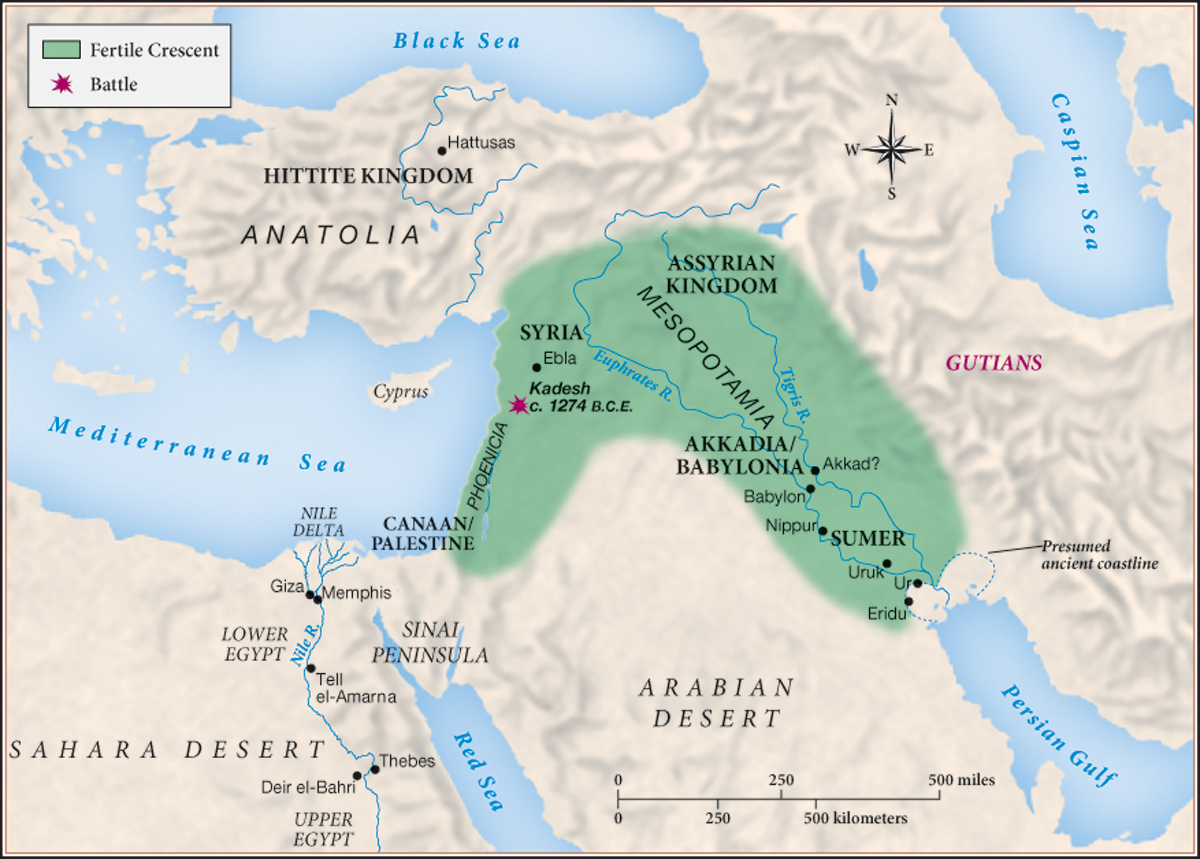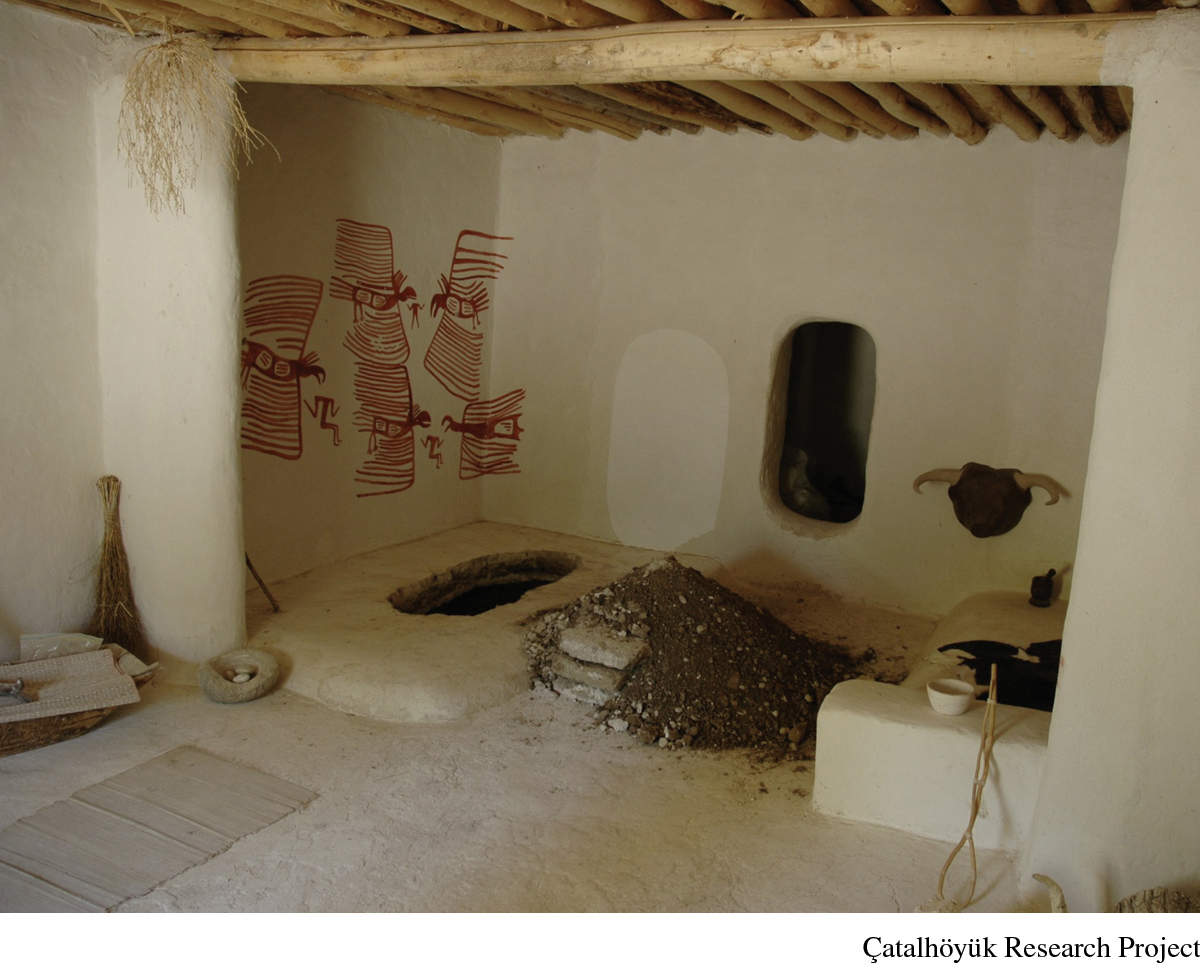Life and Change in the Stone Age
Life and Change in the Stone Age
About four hundred thousand years ago, people whose brains and bodies resembled ours appeared first in Africa. Called Homo sapiens (“wise human beings”), they were the immediate ancestors of modern people. Spreading out from Africa, they gradually populated the rest of the earth. Anthropologists call this time the Stone Age because people made tools and weapons from stone as well as from bone and wood; they did not yet know how to work metals. The Stone Age is divided into an early part, the Paleolithic (“Old Stone”), and a later part, the Neolithic (“New Stone”).
In the Paleolithic Age, people existed as hunter-gatherers who originally lived in mostly egalitarian bands (meaning all adults enjoyed a rough equality in making group decisions). They roamed in groups of twenty to fifty, hunting animals, catching fish and shellfish, and gathering plants, fruits, and nuts. Women with young children foraged for plants close to camp; they provided the group’s most reliable supply of nourishment. Men did most of the hunting of wild animals far from camp, although recent archaeological evidence shows that women also participated, especially in hunting with nets. Objects from distant regions found in burials show that hunter-gatherer bands traded with one another. Trade spread knowledge—especially technology, such as techniques for improving tools, and art for creating beauty and expressing beliefs. The use of fire for cooking was a major innovation because it allowed people to eat wild grains that they could not digest raw.
Evidence from graves shows that hierarchy emerged in Paleolithic times. Some Paleolithic burial sites contain weapons, tools, animal figurines, ivory beads, seashells, and bracelets alongside the corpses; the objects indicate that certain dead persons had greater status and wealth than others. Hierarchy probably began when men acquired prestige from bringing back meat after long hunts and from fighting in wars. (The many traumatic wounds seen in male skeletons show warfare was frequent.) Older women and men also earned status from their experience and longevity, in an age when illness or accidents killed most people before age thirty. The decoration of corpses with red paint and valuable objects suggests that Paleolithic people thought about the mystery of death and perhaps believed in an afterlife. Paleolithic artists also sculpted statuettes of human figures, probably for religious purposes.
Climate and geography—the fundamental features of our natural environment—defined a new way of life for human beings beginning about 10,000 B.C.E. A slow process of transformation started when climate change in the late Paleolithic period brought warmer temperatures and more rainfall at higher elevations. This weather increased the amount of wild grains people could gather in the foothills of the Near East’s Fertile Crescent, an arc of territory extending up from the Jordan valley in Israel, through eastern Turkey, and down into the foothills and plains of Iraq and Iran (Map 1.1).* Paleolithic hunter-gatherers came to settle where wild grains grew abundantly and game animals grazed. Recent archaeological excavation in Turkey suggests that around eleven thousand years ago, groups organized to erect stone monuments to worship gods who they believed helped them to survive, and they started growing food nearby. A more reliable food supply allowed people to raise more children, and increased social organization promoted larger settlements. The more people that were born, however, the greater the need for food became.

After thousands of years of trial and error, people in the Fertile Crescent invented reliable agriculture by sowing seeds from wild grains to produce harvests year after year. This marked the start of the Neolithic Age. Since women had the most experience gathering plants, they probably played the major role in developing farming, while men continued to hunt. Recent research suggests that people also learned to domesticate animals about the same time. By nine thousand years ago, keeping herds for food was widespread in the Near East, which was home to wild animals that could be domesticated, such as sheep, goats, pigs, and cattle.
Historians call agriculture and the domestication of animals the “farming package”; this package created the Neolithic Revolution. The farming package had revolutionary effects because it produced many permanent settlements and food surpluses. Some Neolithic people lived as pastoralists (herders moving around to find grazing land for their animals), while others were farmers who had to reside in a settled location to raise crops. Fixed settlements marked a turning point in the relation between human beings and the environment, as farmers increasingly channeled streams for irrigation. DNA evidence from ancient bones and modern populations shows that by 4000 B.C.E., immigrants and traders from the Fertile Crescent had helped spread knowledge of agriculture and domestication as far as the European shores of the Atlantic Ocean. When farmers began producing more food than they needed, the surpluses allowed other people in the settlement to specialize in architecture, art, crafts, metalwork, textile production, and trade.

The Neolithic Revolution generated more hierarchy because positions of authority were needed to allow some people to supervise the complex irrigation system that supported agricultural surpluses, and because greater economic activity created a stricter division of labor by gender. Men began to dominate agriculture following the invention of heavy wooden plows pulled by oxen, sometime after 4000 B.C.E. Not having to bear and nurse babies, men took over long-distance trade. Women and older children mastered new domestic tasks such as turning milk from domesticated animals into cheese and yogurt and making clothing for themselves and their families. This gendered division of labor arose as an efficient response to the conditions and technologies of the time, but it had the unintended consequence of increasing men’s status.
*In this book, we observe the common usage of the term Near East to mean the lands of southwestern Asia and Egypt.